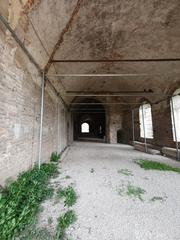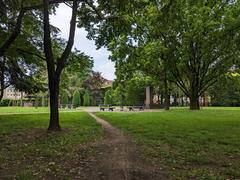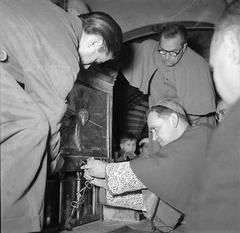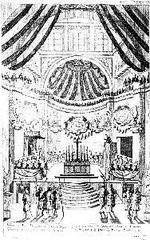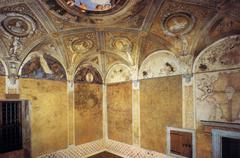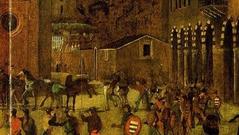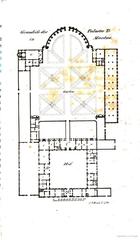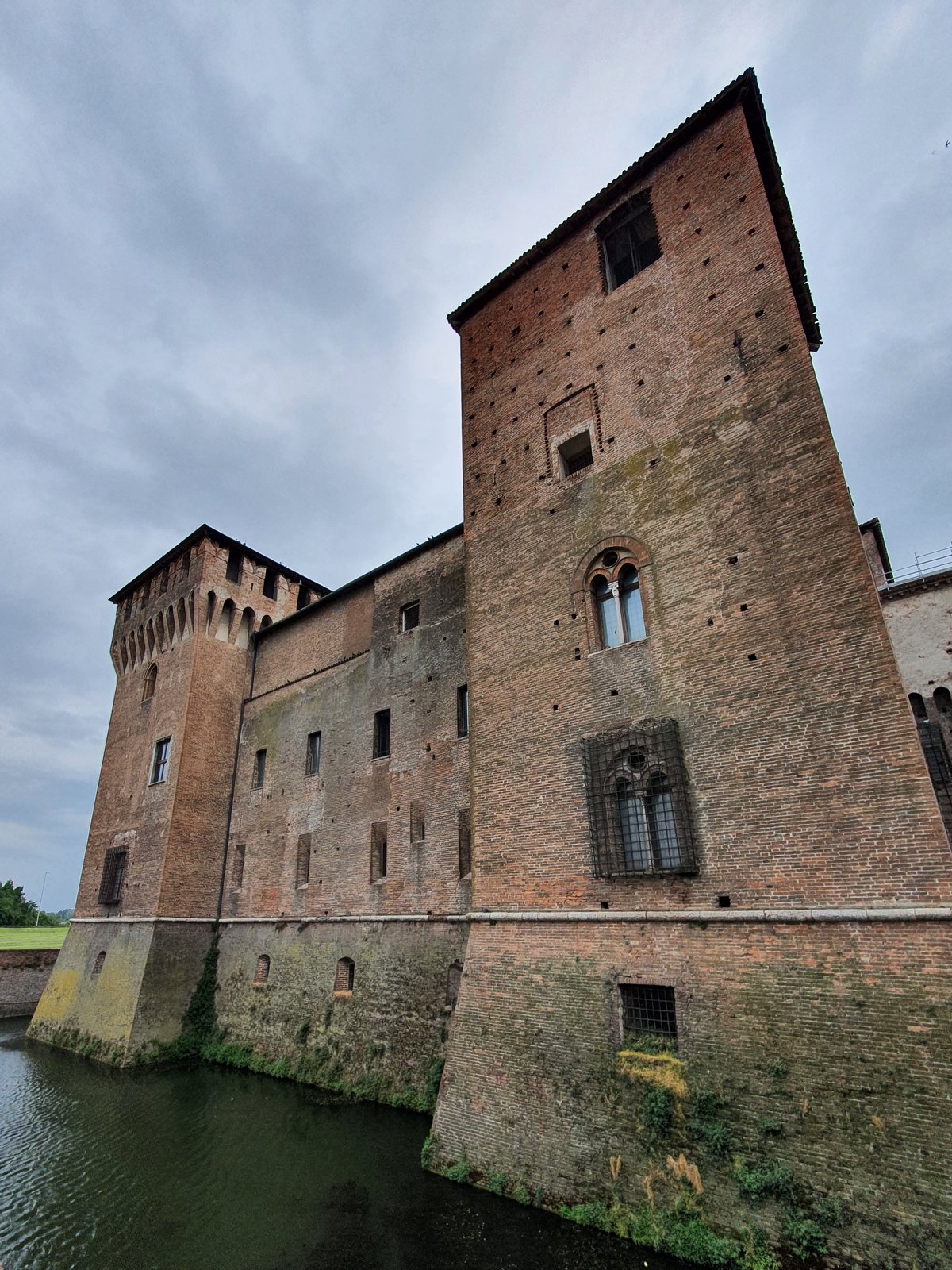
Saint George Castle in Mantua: Visiting Hours, Tickets, and the Complete Guide
Date: 14/06/2025
Introduction
Saint George Castle (Castello di San Giorgio), at the heart of Mantua, Italy, is a spectacular blend of medieval military architecture and Renaissance artistry. Originally commissioned by Francesco I Gonzaga and constructed between 1395 and 1406 by famed architect Bartolino da Novara, the castle served as both a defensive fortress and a symbol of the Gonzaga family’s power during a turbulent era of Italian city-states (Mantova Turismo; Lombardia Beni Culturali).
Over the centuries, Saint George Castle evolved from a formidable stronghold into a luxurious princely residence, especially under Ludovico III Gonzaga. The commissioning of Andrea Mantegna to paint the Camera degli Sposi (Bridal Chamber) marked its transition into a Renaissance masterpiece and a cultural beacon (Musei Mantova; Google Arts & Culture). Today, the castle is an integral part of the expansive Palazzo Ducale complex and a must-visit UNESCO World Heritage Site (UNESCO; Palazzo Ducale Mantova).
This guide provides an in-depth look at Saint George Castle’s history, architecture, artistic significance, visiting hours, ticketing options, practical tips, accessibility, and nearby attractions to help you plan a memorable visit.
Table of Contents
- Historical Overview & Construction
- The Gonzaga Dynasty and Artistic Transformation
- Architectural Features & Renaissance Innovations
- Cultural and Political Role
- Modern Era: Restoration and Public Access
- Notable Historical Events and Anecdotes
- Visiting Information: Hours, Tickets, and Accessibility
- Travel Tips and How to Get There
- Preservation and UNESCO Recognition
- FAQ
- Practical Visitor Recommendations
- Summary and Key Points
- Sources and Official Links
Historical Overview & Construction
Saint George Castle stands as a testament to the ambitions of the Gonzaga family, rulers of Mantua for centuries. Its construction commenced in 1395 and was completed in 1406, overseen by Bartolino da Novara, who was renowned for his innovations in military architecture (Mantova Turismo). The castle was strategically placed on the northeastern edge of Mantua, adjacent to medieval city walls and surrounded by a water-filled moat fed by Lago di Mezzo.
The square layout, corner towers, and defensive features exemplify the military priorities of the era, reflecting the unstable political climate of late 14th-century northern Italy (Lombardia Beni Culturali).
The Gonzaga Dynasty and Artistic Transformation
While Saint George Castle was initially conceived as a fortress, it rapidly became the seat of Gonzaga power and refinement. The pivotal transformation occurred in the mid-15th century under Ludovico III Gonzaga, who sought to impress Pope Pius II by commissioning Andrea Mantegna to decorate the Camera degli Sposi (Musei Mantova). Completed between 1465 and 1474, this room’s frescoes depict intimate family scenes and diplomatic meetings, revolutionizing Renaissance art through the use of perspective and trompe-l’œil (Google Arts & Culture).
Architectural Features & Renaissance Innovations
The castle’s original design included a square plan, four cylindrical corner towers, a drawbridge, and a deep moat. Its brick and stone walls were built to withstand sieges and artillery, while later modifications reflected the changing tastes of the Renaissance court (Mantova Turismo).
Key Renaissance adaptations included:
- Addition of large windows and elegant porticoes
- Integration into the vast Palazzo Ducale, one of Europe’s largest palace complexes (Palazzo Ducale Mantova)
- Interior embellishments with frescoes, tapestries, and ornate furnishings (Spotting History; Italyscapes)
Cultural and Political Role
During the Renaissance, Saint George Castle became a center for art, diplomacy, and courtly life. It hosted royal weddings, diplomatic receptions, and housed visiting dignitaries. The Camera degli Sposi, in particular, became a symbol of the Gonzagas’ sophistication and influence (Enciclopedia Treccani).
The castle also played a defensive role during events like the 1630 siege in the War of the Mantuan Succession, cementing its importance in Mantua’s history (Britannica).
Modern Era: Restoration and Public Access
After the Gonzaga dynasty’s decline, the castle suffered periods of neglect, especially during Austrian rule when it was used as barracks and a prison (Mantova Turismo). Major restoration efforts in the 20th and 21st centuries have preserved its architecture and priceless frescoes, particularly the Camera degli Sposi (Musei Mantova). Today, it welcomes thousands of visitors annually as part of the Palazzo Ducale museum network.
Notable Historical Events and Anecdotes
- Arrival of Isabella d’Este: In 1479, Isabella d’Este, a major patron of the arts, joined the Gonzaga court through marriage, ushering in a golden age for Mantua (Google Arts & Culture).
- Prison and Resistance: In the 19th century, the castle housed political prisoners, including figures of the Italian Risorgimento (Wikipedia).
- Restoration and UNESCO Status: The castle’s conservation and its role in Mantua’s UNESCO designation in 2008 underscore its enduring significance (UNESCO).
Visiting Information: Hours, Tickets, and Accessibility
Opening Hours
- Typical hours: Tuesday to Sunday, 8:15 am – 7:15 pm (last entry at 6:15 pm)
- Closed: Mondays and select holidays
- Note: Hours may vary during special events; check the official website before your visit.
Ticket Information
- Standard admission: €15–€20 (depending on exhibitions and combined entry with Palazzo Ducale)
- Reductions: Students, seniors, EU citizens aged 18–25, children under 18 (often free)
- Free entry: First Sunday of each month (as part of Italy’s “Domenica al Museo” initiative)
- Advance booking: Highly recommended, especially for the Camera degli Sposi
- Where to buy: Palazzo Ducale Official, on-site ticket office
Accessibility
- Most public areas are wheelchair accessible, with elevators and ramps available
- Tactile maps and guided tours in Italian Sign Language (LIS) for visitors with disabilities (Accessible Italy)
- Facilities for families, including baby-changing and stroller access (except in the Camera degli Sposi)
Travel Tips and How to Get There
- Location: Piazza Sordello, Mantua—central, within the Palazzo Ducale complex
- By train: 15-minute walk from Mantua railway station
- By bus: Stops at Piazza Sordello and nearby city lots
- Parking: Piazza Virgiliana and other city lots (arrive early during peak season)
- Suggested visit duration: 2–3 hours, longer if exploring the entire Palazzo Ducale
Preservation and UNESCO Recognition
Saint George Castle, along with Mantua’s historic center, is a UNESCO World Heritage Site, recognized for its Renaissance urban planning and architecture (UNESCO). Ongoing preservation ensures the safeguarding of its structural and artistic treasures for future generations (Palazzo Ducale Mantova).
FAQ
Q: What are the visiting hours for Saint George Castle?
A: Typically open Tuesday to Sunday, 8:15 am to 7:15 pm, last entry 6:15 pm. Closed Mondays.
Q: How do I book tickets?
A: Online via the official site or at the on-site ticket office. Advance booking is highly recommended.
Q: Is the castle wheelchair accessible?
A: Yes, most public areas are accessible, with staff assistance available.
Q: Can I take photos inside?
A: Photography without flash is permitted, except in the Camera degli Sposi.
Q: Are guided tours available?
A: Yes, in Italian and English. Audio guides are also offered.
Q: What other sites are nearby?
A: Palazzo Ducale, Piazza Sordello, Rotonda di San Lorenzo, Teatro Bibiena.
Practical Visitor Recommendations
- Book tickets early, especially for the Camera degli Sposi
- Wear comfortable shoes (stone floors and stairs)
- Check the latest event and exhibition schedules
- Allow extra time for exploring the entire Palazzo Ducale complex
- Download audio guides or the Audiala app for enhanced experience
Summary of Key Points
Saint George Castle is a living monument to Mantua’s illustrious past, from its fortress origins to its transformation as a Renaissance palace. The Camera degli Sposi stands as one of Italy’s greatest artistic achievements. With accessible facilities, organized tours, and a central location within Mantua’s historic core, the castle is an essential destination for lovers of history, art, and architecture (Mantova Turismo; Google Arts & Culture; UNESCO; Palazzo Ducale Mantova; Life in Italy).
Sources and Official Links
- Saint George Castle Mantua: Visiting Hours, Tickets & Historical Guide, Mantova Turismo
- Castello di San Giorgio, Mantua, Lombardia Beni Culturali
- Il Castello di San Giorgio, Musei Mantova
- The Camera degli Sposi Mantua, Google Arts & Culture
- Saint George Castle in Mantua: Visiting Hours, Tickets, History, and Artistic Highlights, Spotting History
- Castello di San Giorgio, Mantua, Wikipedia
- Castello di San Giorgio, Mantua, Italia.it
- Mantua, Encyclopædia Britannica
- Saint George Castle Mantua: Visiting Hours, Tickets & Cultural Highlights, Grantourismotravels.com
- Mantua UNESCO World Heritage Site, UNESCO
- Saint George Castle Visiting Hours, Tickets, and Guide, 2025, Palazzo Ducale Official
For more travel advice, downloadable audio guides, and Mantua itineraries, visit the Palazzo Ducale Mantova official website.

